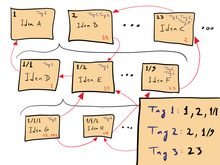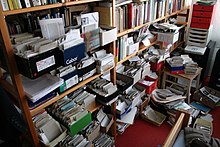Zettelkasten
The zettelkasten (German: "slip box") is a method of note-taking and personal knowledge management used in research and study.
Method[edit source]
A zettelkasten consists of many individual notes with ideas and other short pieces of information that are taken down as they occur or are acquired. The notes are numbered hierarchically, so that new notes may be inserted at the appropriate place, and contain metadata to allow the note-taker to associate notes with each other. For example, notes may contain tags that describe key aspects of the note, and they may reference other notes. The numbering, metadata, format and structure of the notes is subject to variation depending on the specific method employed.
A zettelkasten may be created and used in a digital format, sometimes using specialist knowledge management software. But it can be and has long been done on paper using index cards.
The method not only allows a researcher to store and retrieve information related to their research, but also intends to enhance creativity[citation needed]. Cross-referencing notes through tags allows the researcher to perceive connections and relationships between individual items of information that may not be apparent in isolation[citation needed]. These emergent aspects of the method make the zettelkasten somewhat similar to a neural network[citation needed] with which one may "converse".[1]
History[edit source]
In the form of paper index cards in boxes, the zettelkasten (plural: Zettelkästen) has long been used by individual researchers and by organizations to manage information, including notably in the specialized form of the library catalog. It was pioneered by Conrad Gessner (1516–1565) and was described in detail by Johann Jacob Moser (1701–1785).[2] The 1794 idyll Leben des Quintus Fixlein by Jean Paul is structured according to the zettelkasten in which the protagonist keeps his autobiography.[2]
One researcher famous for his extensive use of the method was the sociologist Niklas Luhmann (1927–1998). Luhmann built up a zettelkasten of some 90,000 index cards for his research, and credited it for enabling his extraordinarily prolific writing (including over 70 books and 400 scholarly articles).[3] He linked the cards together by assigning each a unique index number based on a branching hierarchy.[4] These index cards were digitized and made available online in 2019.[5] Luhmann described the zettelkasten as part of his research into systems theory in the essay "Kommunikation mit Zettelkästen".[6]
See also[edit source]
References[edit source]
- ^ Mittelmann, Angelika; Della Schiava, Manfred (2019). Wissensmanagement wird digital (in German). Norderstedt: Books on Demand. pp. 63–65. ISBN 9783746027654. OCLC 1111829173.
- ^ a b Haarkötter, Hektor. "'Alles Wesentliche findet sich im Zettelkasten'". heise online (in German). Archived from the original on 2020-07-15. Retrieved 2020-05-31.
- ^ Schmidt, Johannes. "Niklas Luhmann's Card Index: Thinking Tool, Communication Partner, Publication Machine" (PDF). In Cevolini, Alberto (ed.). Forgetting Machines: Knowledge Management Evolution in Early Modern Europe. Leiden; Boston: Brill. pp. 289–311. doi:10.1163/9789004325258_014. ISBN 9789004278462. OCLC 951955805. Archived (PDF) from the original on 2020-11-27. Retrieved 2020-09-04.
- ^ Beaudoin—Zapier, Jack (2 August 2020). "This simple but powerful analog method will rocket your productivity". Fast Company. Archived from the original on 17 November 2020. Retrieved 13 November 2020.
- ^ Noack, Pit. "Missing Link: Luhmanns Denkmaschine endlich im Netz". heise online (in German). Archived from the original on 2020-07-12. Retrieved 2020-05-31.
- ^ Luhmann, Niklas. "Kommunikation mit Zettelkästen. Ein Erfahrungsbericht", in: André Kieserling (ed.), Universität als Milieu. Kleine Schriften, Haux, Bielefeld 1992 (essay originally published 1981), ISBN 3-925471-13-8, p. 53–61; translated in: "Communicating with Slip Boxes". luhmann.surge.sh. Archived from the original on 2020-06-17. Retrieved 2020-05-31.


